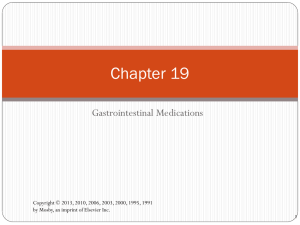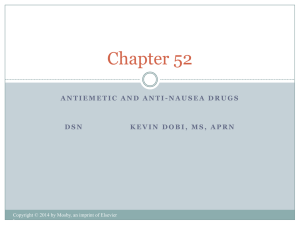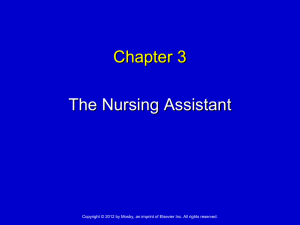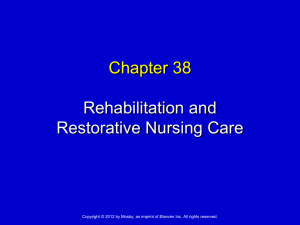Laxative Group Use
advertisement
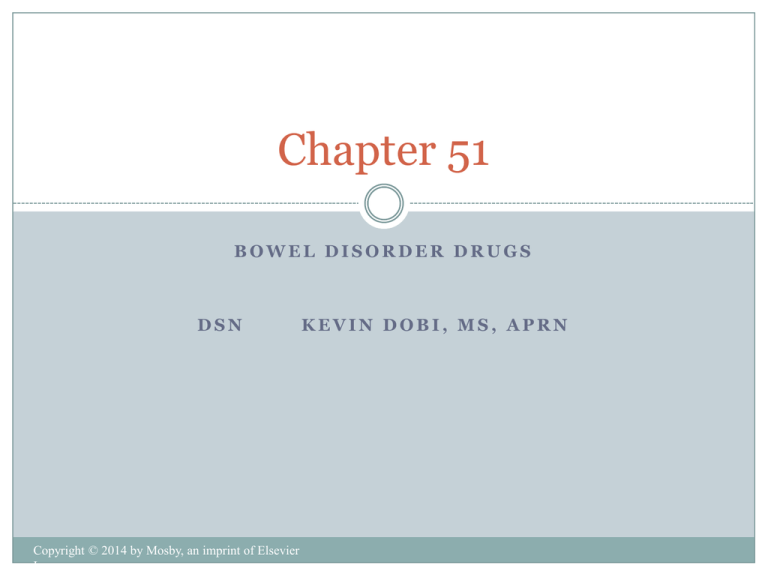
Chapter 51 BOWEL DISORDER DRUGS DSN Copyright © 2014 by Mosby, an imprint of Elsevier Inc. KEVIN DOBI, MS, APRN 2 Copyright © 2014 by Mosby, an imprint of Elsevier Inc. Diarrhea 3 Abnormal passage of stools with increased frequency, fluidity, and weight, or with increased stool water excretion Copyright © 2014 by Mosby, an imprint of Elsevier Inc. Diarrhea4 (cont’d) Acute diarrhea Sudden onset in a previously healthy person Lasts from 3 days to 2 weeks Self-limiting Resolves without sequelae Copyright © 2014 by Mosby, an imprint of Elsevier Inc. Diarrhea5 (cont’d) Chronic diarrhea Lasts for more than 3-4 weeks Associated with recurring passage of diarrheal stools, fever, loss of appetite, nausea, vomiting, weight loss, and chronic weakness Copyright © 2014 by Mosby, an imprint of Elsevier Inc. Causes of6 Diarrhea Acute Diarrhea Diarrhea Bacteria Viruses Drug-induced Nutritional factors Protozoa Copyright © 2014 by Mosby, an imprint of Elsevier Inc. Chronic Tumors Diabetes mellitus Addison’s disease Hyperthyroidism Irritable bowel syndrome AIDS Goals of Diarrhea Treatment 7 Stopping the stool frequency Alleviating the abdominal cramps Replenishing fluids and electrolytes Preventing weight loss and nutritional deficits from malabsorption Copyright © 2014 by Mosby, an imprint of Elsevier Inc. Antidiarrheals 8 Adsorbents Antimotility drugs (anticholinergics and opiates) Probiotics (bacterial replacement drugs) Copyright © 2014 by Mosby, an imprint of Elsevier Inc. Antidiarrheals: Mechanism 9 of Action Adsorbents Coat the walls of the gastrointestinal (GI) tract Bind to the causative bacteria or toxin, which is then eliminated through the stool Examples: bismuth subsalicylate (Pepto-Bismol), activated charcoal, aluminum hydroxide, others Copyright © 2014 by Mosby, an imprint of Elsevier Inc. Antidiarrheals: Mechanism of 10Action (cont’d) Antimotility drugs: anticholinergics Decrease intestinal muscle tone and peristalsis of GI tract Result: slows the movement of fecal matter through the GI tract Examples: belladonna alkaloids Copyright © 2014 by Mosby, an imprint of Elsevier Inc. Antidiarrheals: Mechanism of 11Action (cont’d) Antimotility drugs: opiates Decrease bowel motility and reduce pain by relief of rectal spasms Decrease transit time through the bowel, allowing more time for water and electrolytes to be absorbed Examples: paregoric, opium tincture, codeine, loperamide (over the counter), diphenoxylate Copyright © 2014 by Mosby, an imprint of Elsevier Inc. Antidiarrheals: Mechanism of 12Action (cont’d) Probiotics Also known as intestinal flora modifiers and bacterial replacement drugs Bacterial cultures of Lactobacillus organisms work by: Supplying missing bacteria to the GI tract Suppressing the growth of diarrhea-causing bacteria Example: L. acidophilus (Bacid) Copyright © 2014 by Mosby, an imprint of Elsevier Inc. Classroom Response Question 13 The antidiarrheal drug Lomotil contains both diphenoxylate, a synthetic opiate agonist, and atropine, an anticholinergic. The purpose of the atropine in this combination is to A. B. C. D. enhance the effects of the diphenoxylate. discourage recreational use of the opiate diphenoxylate. counteract the adverse effects of the diphenoxylate. act as an adsorbent for bacteria in the bowel. Copyright © 2014 by Mosby, an imprint of Elsevier Inc. Antidiarrheals: Adverse14 Effects Adsorbents Increased bleeding time Constipation, dark stools Confusion Tinnitus Metallic taste Blue tongue Copyright © 2014 by Mosby, an imprint of Elsevier Inc. Antidiarrheals: Adverse Effects (cont’d) 15 Anticholinergics Urinary retention, impotence Headache, dizziness, confusion, anxiety, drowsiness, confusion Dry skin, flushing Blurred vision Hypotension, bradycardia Copyright © 2014 by Mosby, an imprint of Elsevier Inc. Antidiarrheals: Adverse Effects (cont’d) 16 Opiates Drowsiness, dizziness, lethargy Nausea, vomiting, constipation Respiratory depression Hypotension Urinary retention Flushing Copyright © 2014 by Mosby, an imprint of Elsevier Inc. Antidiarrheals: 17 Interactions Adsorbents decrease the absorption of many drugs, including digoxin, quinidine, and hypoglycemic drugs Adsorbents cause increased bleeding time and bruising when given with anticoagulants (warfarin) Toxic effects of methotrexate are more likely when given with adsorbents Copyright © 2014 by Mosby, an imprint of Elsevier Inc. Antidiarrheals: Nursing Implications 18 Obtain thorough history of bowel patterns, general state of health, and recent history of illness or dietary changes; assess for allergies Do NOT give bismuth subsalicylate to children or teenagers with chickenpox or influenza because of the risk of Reye’s syndrome Copyright © 2014 by Mosby, an imprint of Elsevier Inc. Classroom Response Question 19 Before administering belladonna alkaloids, it is most important for the nurse to assess the patient for a history of which condition? A. B. C. D. Anemia Diabetes mellitus Myasthenia gravis Hypertension Copyright © 2014 by Mosby, an imprint of Elsevier Inc. Antidiarrheals: Nursing Implications (cont’d) 20 Use adsorbents carefully in elderly patients or those with decreased bleeding time, clotting disorders, recent bowel surgery, confusion Do not administer anticholinergics to patients with a history of narrow-angle glaucoma, GI obstruction, myasthenia gravis, paralytic ileus, and toxic megacolon Copyright © 2014 by Mosby, an imprint of Elsevier Inc. Antidiarrheals: Nursing Implications (cont’d) 21 Teach patients to take medications exactly as prescribed and to be aware of their fluid intake and dietary changes Assess fluid volume status, I&O, and mucous membranes before, during, and after initiation of treatment Copyright © 2014 by Mosby, an imprint of Elsevier Inc. Antidiarrheals: Nursing Implications (cont’d) 22 Teach patients to notify their prescriber immediately if symptoms persist Monitor for therapeutic effect Copyright © 2014 by Mosby, an imprint of Elsevier Inc. Classroom Response Question 23 Which antidiarrheal does the nurse associate with the development of adverse effects of urinary retention, headache, confusion, dry skin, rash, and blurred vision? A. B. C. D. Anticholinergics Adsorbents Probiotics Opiates Copyright © 2014 by Mosby, an imprint of Elsevier Inc. Constipation 24 Abnormally infrequent and difficult passage of feces through the lower GI tract Symptom, not a disease Disorder of movement through the colon and/or rectum Can be caused by a variety of diseases or drugs Copyright © 2014 by Mosby, an imprint of Elsevier Inc. Laxatives 25 Bulk-forming Emollient (stool softeners, lubricant laxatives) Hyperosmotic Saline Stimulant Peripherally acting opioid Copyright © 2014 by Mosby, an imprint of Elsevier Inc. Laxatives: Mechanism of Action 26 Bulk-forming High fiber Absorb water to increase bulk Distend bowel to initiate reflex bowel activity Examples psyllium (Metamucil) methylcellulose (Citrucel) Copyright © 2014 by Mosby, an imprint of Elsevier Inc. Laxatives: Mechanism of Action (cont’d) 27 Emollient Stool softeners and lubricants Promote more water and fat in the stools Lubricate the fecal material and intestinal walls Examples Stool softeners: docusate salts (Colace, Surfak) Lubricants: mineral oil Copyright © 2014 by Mosby, an imprint of Elsevier Inc. Laxatives: Mechanism of Action (cont’d) 28 Hyperosmotic Increase fecal water content Results in bowel distention, increased peristalsis, and evacuation Examples: Polyethylene glycol (PEG) Sorbitol, glycerin Lactulose (also used to reduce elevated serum ammonia levels) Copyright © 2014 by Mosby, an imprint of Elsevier Inc. Laxatives: Mechanism of Action (cont’d) 29 Saline Increase osmotic pressure within the intestinal tract, causing more water to enter the intestines Results in bowel distention, increased peristalsis, and evacuation Examples Magnesium hydroxide (Milk of Magnesia) Magnesium citrate (Citroma) Copyright © 2014 by Mosby, an imprint of Elsevier Inc. Laxatives: Mechanism of Action (cont’d) 30 Stimulant Increases peristalsis via intestinal nerve stimulation Examples senna (Senekot) bisacodyl (Dulcolax) Copyright © 2014 by Mosby, an imprint of Elsevier Inc. Peripherally Acting31Opioid Antagonists Treatment of constipation related to opioid use and bowel resection therapy Block entrance of opioid into bowel Strict regulations for use Allow bowel to function normally with continued opioid use methylnaltrexone (Relistor) alvimopan (Entereg) Copyright © 2014 by Mosby, an imprint of Elsevier Inc. Laxatives: 32Indications Laxative Group Bulk-forming Emollient Copyright © 2014 by Mosby, an imprint of Elsevier Inc. Use Acute and chronic constipation, irritable bowel syndrome, diverticulosis Acute and chronic constipation, fecal impaction, facilitation of bowel movements in anorectal conditions Laxatives: Indications (cont’d) 33 Laxative Group Hyperosmotic Saline Stimulant Copyright © 2014 by Mosby, an imprint of Elsevier Inc. Use Chronic constipation, diagnostic and surgical preps Constipation, diagnostic and surgical preps Acute constipation, diagnostic and surgical preps Classroom Response Question 34 A patient is receiving lactulose four times a day but does not have a history of constipation. In fact, he has had bowel movements every day. What is the probable reason for the lactulose? A. Cleansing the bowel before a procedure B. Removal of helminths C. Reduction of high ammonia levels associated with liver failure D. Daily maintenance to prevent constipation Copyright © 2014 by Mosby, an imprint of Elsevier Inc. Laxatives: Adverse Effects 35 Bulk-forming Impaction Fluid overload Electrolyte imbalances Esophageal blockage Emollient Skin rashes Decreased absorption of vitamins Electrolyte imbalances Lipid pneumonia Copyright © 2014 by Mosby, an imprint of Elsevier Inc. Laxatives: Adverse 36 Effects (cont’d) Hyperosmotic Abdominal bloating Electrolyte imbalances Rectal irritation Saline Magnesium toxicity (with renal insufficiency) Cramping Electrolyte imbalances Diarrhea Increased thirst Copyright © 2014 by Mosby, an imprint of Elsevier Inc. Laxatives: Adverse 37 Effects (cont’d) Stimulant Nutrient malabsorption Skin rashes Gastric irritation Electrolyte imbalances Discolored urine Rectal irritation All laxatives can cause electrolyte imbalances! Copyright © 2014 by Mosby, an imprint of Elsevier Inc. Laxatives: Nursing Implications 38 Obtain a thorough history of presenting symptoms, elimination patterns, and allergies Assess fluid and electrolytes before initiating therapy Inform patients not to take a laxative or cathartic if they are experiencing nausea, vomiting, and/or abdominal pain Copyright © 2014 by Mosby, an imprint of Elsevier Inc. Laxatives: Nursing Implications (cont’d) 39 A healthy, high-fiber diet and increased fluid intake should be encouraged as an alternative to laxative use Long-term use of laxatives often results in decreased bowel tone and may lead to dependency All laxative tablets should be swallowed whole, not crushed or chewed, especially if enteric coated Copyright © 2014 by Mosby, an imprint of Elsevier Inc. Laxatives: Nursing Implications (cont’d) 40 Patients should take all laxative tablets with 6 to 8 oz of water Patients should take bulk-forming laxatives as directed by the manufacturer with at least 240 mL (8 oz) of water Copyright © 2014 by Mosby, an imprint of Elsevier Inc. Laxatives: Nursing Implications (cont’d) 41 Give bisacodyl with water because of interactions with milk, antacids, and juices Inform patients to contact their prescriber if they experience severe abdominal pain, muscle weakness, cramps, and/or dizziness, which may indicate possible fluid or electrolyte loss Monitor for therapeutic effect Copyright © 2014 by Mosby, an imprint of Elsevier Inc. Classroom Response Question 42 A 48-year-old patient has been admitted with abdominal pain, and states that she has not had a bowel movement for 4 days. Her abdomen is distended and slightly tender. Which laxative would be appropriate for this patient? A. Milk of magnesia B. A bulk-forming laxative C. Mineral oil D. No laxative should be given at this time Copyright © 2014 by Mosby, an imprint of Elsevier Inc. Irritable Bowel Syndrome 43 Chronic intestinal discomfort characterized by cramps, diarrhea, and/or constipation Patients usually cope with the symptoms by avoiding irritating foods and/or taking over-thecounter (OTC) laxatives and antidiarrheal drugs Copyright © 2014 by Mosby, an imprint of Elsevier Inc. Drugs for Irritable44 Bowel Syndrome tegaserod (Zelnorm) lubiprostone (Amitiza) alosetron (Lotronex) Copyright © 2014 by Mosby, an imprint of Elsevier Inc. Drugs for Irritable Bowel Syndrome: Nursing Implications 45 Perform a general assessment and additional assessment of liver functioning as well as assessment for any underlying cardiac disease Follow administration guidelines Assess for therapeutic response Copyright © 2014 by Mosby, an imprint of Elsevier Inc.
